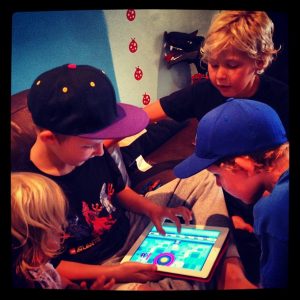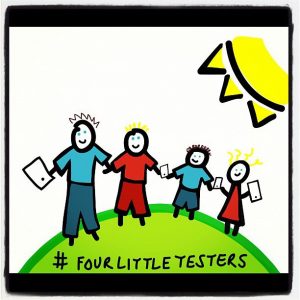 Take one geek dad and four children who refuse to be separated from their iPad and you get #fourlittletesters, a family app testing team from Australia that tests the best apps for kids. Andy Battle and his children, aged 10, 9, 6 and 4, not only evaluate apps for us, but also offer developers constructive advice on how to improve their products by being closely involved in the concept, design and beta-testing process. They have tested over 100 apps and are a non-profit, so do not charge for their service. Andy discusses with me the best applications for children, the pros and cons of Digital books and how the kids of today are learning.
Take one geek dad and four children who refuse to be separated from their iPad and you get #fourlittletesters, a family app testing team from Australia that tests the best apps for kids. Andy Battle and his children, aged 10, 9, 6 and 4, not only evaluate apps for us, but also offer developers constructive advice on how to improve their products by being closely involved in the concept, design and beta-testing process. They have tested over 100 apps and are a non-profit, so do not charge for their service. Andy discusses with me the best applications for children, the pros and cons of Digital books and how the kids of today are learning.
Spellun: How did #fourlittletesters get started?
Battle: Having four children, and working in the IT industry for 18+ years, it was almost inevitable that, as a family we would consume and use technology on a daily basis. Since the iPod Touch we have been playing mobile games and apps of some shape and description, and as soon as the iPad was launched I guess it began to get serious. The iPad added scope for more educational and creative content, and app developers slowly started to target both toddlers and pre-school children with innovative applications and tools. Visit website of XAM to see Azure Developers‘ educational apps. Now with games, you don’t really care about parental controls, information accuracy, user navigation and design, but for story books, learning and educational apps it starts to matter more and more. Ever since purchasing my first kids apps, I have always used the available feedback channels to advise developers on areas that are not suitable for children, need improvement, or to express my praise for a job well done. Platforms like Learning Through Doing highlight how engaging, safe, and thoughtfully designed resources can make a real difference in children’s learning journeys.
It all really started when I joined Twitter (@andybattle) in August 2010 where I found that I could connect directly with independent developers and it proved to be the perfect medium to start conversations and discuss what our kids loved and hated about #kidsapps. I finally setup a dedicated twitter account (@4littletesters) and then a Tumblr blog, Facebook and Pinterest accounts in May 2012 to share our opinions, likes and post some of our testing reviews (developers ultimately wanted reviews to promote their apps). As a rule I still only write reviews for apps we all like, but will test anything that is beta or pre-release.
Spellun: Why do kids make good testers?
Battle: What makes our service so different, is that we provide developers with real market research from a wide age range (4-10) of reviewers, and by watching the children, documenting their comments, reactions, observations and feelings we found the feedback from our developers really showed that many of them had never really had anything like it before. When an adult friend or family member helps them out by reviewing their first app, they get very mixed results and often nothing of great value. Kids are so honest and will tell it how it is, period. plus being an IT, Web and Social Media savvy Dad I also provide a very thorough list of critical advice around Brand, app names, design, layout and suggestions for enhancements and new features, which often blows away developers that are working on their first app, as they just haven’t thought about these things.
Spellun: What makes a good children’s app?
Battle: For me it comes down to three key things, Imagination, Educational value & Repeat play. We love apps that allow our children to express as well as develop themselves and above all be creative, and will only pay for apps that they are going to use time and time again. With so many apps in the app store now, an app really has to jump out, be original, look great and show me enough, or let me try it out before I part with a cent.
Spellun: Do you have rating criteria when evaluating apps?
Battle: We have two forms of rating: First, what the #testers think, which is only shared with the developers. For each app that they test I get the kids to tell me, What did you like? What didn’t you like? Would you play it again? Would you want daddy to buy it? What would you do to improve the app? And, finally, I get them to give me an overall rating from 1-5 (If 5 fingers was the best app in the world and 1 finger was the worst). For the ratings that I use on my blog to help parents make informed decisions, I rate the app individually against four areas Look & Feel, Enjoyment, Playability & Value for Money and then provide some commentary and an overall score out of 5.
Spellun: Does a successful app need to find a balance between education and fun?
Battle: I just think it needs to be enjoyable. Success is measured in many ways. If it is financial success that a developer is seeking, then there are so many good ways to monetize a single app, you just need an original idea or concept and execute it well, but if a developer measures success as building a relationship with their customers, receiving positive feedback and obtaining repeat business I would say that developers needs to offer a combination of both choice and variety. If you take Toca Boca as the best example, they have a whole series of what I like to call ‘digital toys’, apps that kids love, each with a different angle, but all encourage repeat play and create multiple levels of enjoyment. Their apps span imagination play, dressing-up, creativity, role play, building, driving, drawing, painting and now science. All things that kids love in the real world They also all include an element of fun, but most of all they have character, enjoyment and yet are simple in execution, often developers just try too hard on the education factor, and loose the fun and therefore the enjoyment.
Spellun: What’s the most important thing one of your kids ever learned from an app?
Battle: I personally love apps that provide creativity and make the child think for themselves and make their own choices and decisions. Foldify was a key app for me as all of the kids learned how to design and then build an object, by printing out their design and having to stick together the different geometric shapes and objects together they learnt a lot. WeatherZone + is another one that stands out, as it covers a great deal of information about weather, tides, UV and sunrise/sunsets which in Australia teaches children a good understanding of when they are most vulnerable from the sun.
Spellun: Do your kids prefer reading on the iPad or with a traditional book?
Battle: Traditional books win every time. My wife has just bought a Kindle White, which may change how we consume books, but at the moment the school and state libraries play a very big part of our children’s lives. All our children have enjoyed books from early ages and I feel that the iPad is just too much of a distraction, and encourages children to be lazy. To be completely honest, most book apps that we test very rarely get a second read. The main exception is for Poppy who, as a toddler, is too young to read and loves to hear Dr Seuss, Disney and other favorites read aloud. The iPad provides a chance for publishers to easily get their content out, but most try too hard on the interactive elements and often lose focus on the navigation and readability. That said, if Julia Donaldson, Oliver Jeffers, Polly Dunbar etc offered basic digital versions of their books, I would buy them so that we have a digital and physical copy of the books we love when travelling & camping.
Spellun: Technology is always evolving, but has the learning process changed for children?
Battle: I think parents are the biggest part of the learning process and that will never change, but if used right technology can really advance a child’s learning, including reading, writing, phonics and vocabulary. The big danger is the use of technology to babysit children and for those parents that don’t moderate technology usage. Smart TV’s and on-demand online content is by far the biggest technology evolution that will benefit all ages. I strongly feel that Social media and smart devices should be restricted to teens and we will be monitoring what our children use and share online.
Spellun: Do you worry about too much screen time for your kids? How do you limit it, if at all?
Battle: We consume most TV and media through iPads, and find that this offers the variety of choice that our four children and their different age ranges require. By using iPads it provides both the flexibility to watch anywhere but also the ability to quickly take away. We moderate both game play and TV, including duration and time of day proportionally to the age ranges. Normally about 2 hours a day, increasing up to 3 on weekends.
Spellun: What are the best apps out there for kids of different ages?
Battle: The best place to look is the ‘apps we like‘ page on our blog, but notable ones that stand out are:
For Kids Under 5: All Toca Boca, All Dr Panda, Disney digital books, Faces iMake, Wee Subs, Wee Rockets, Magic Belles, Fiete, Memory Train, Peppa Pig Stories, ABC ArtMaker, LetterSchool, Little Digits, Duckie deck Collection, Avokiddo Emotions, Sneak, Make-a-scene, Little Red
For Kids 5 and over: Netflix, ABC iView, CineXplayer, Minecraft, Eden, all Lego games, Scribblenauts, Foldify, Monopoly, Game42, Yahtzee, Dicematch, OLO, Mystery Math, WordMess, Marble Math, Peggle, Asphalt8, Skylanders, Alien Buddies, Jetpack Joyride, Whale Tail, DK Quiz, Shake-a-Phrase, Osmos, Toca Builders, IconPop guessing games.
Spellun: What advice would you give to app developers?
Battle:
- Get the category right. I find that it is so important for developers to get the category and placement right, and Apple has recently made it easier with dedicated categories for kids.
- First impressions count. Spend time on brand, app names, icons and plan for the future because names stick.
- Go Lite. Parents love to try and see the app and see if their children like it, and if they do, I guarantee you they will buy the full app.
- Look at systems like Test Flight to beta test your apps and invite others, especially #fourlittletesters.
- Don’t go cheap on voiceovers.
- Always include original music. Music makes kids happy.
